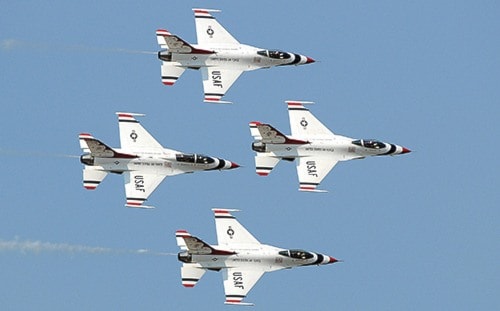Looming budget decisions in the U.S. may determine whether Abbotsford sees American military aircraft at this year’s airshow.
The growing national debt in the U.S., which now stands at more than $16 trillion, has led to potential automatic federal funding decreases in an attempt to control spending.
The first instalment of cuts, totalling $85 billion, could begin on March 1, and the International Council of Air Shows (ICAS) has said this will affect American military plane attendance at airshows across North America.
It means the highly popular Blue Angels and the USAF Thunderbirds aerial demonstration teams, and static displays of military aircraft, may no longer participate.
The Thunderbirds performed at last year's airshow, their only performance in Canada that year.
Jim Reith, incoming president of the Abbotsford Airshow, said the issue has led to some uncertainty about which acts will appear.
But Canadians will fare better than their American counterparts, as shows will still have access to Canadian planes, he said.
“On the Canadian side we’re still in good shape. We have confirmations already from the Canadian Forces Snowbirds and the CF-18 Hornets.”
The biggest impact will be on the static line-up of planes – a display that Reith said Abbotsford is known for.
“Now the American ones won’t be able to come, so we will be relying on Canadian aircraft, which usually only form half of that line.”
Reith isn’t worried about the impact on the quality of the show or ticket sales, saying that they are already working on alternate plans, which will include hiring civilian performers alongside the Snowbirds and Skyhawks.
“I think we’ll have a very solid flying display line-up. So I don’t think it should impact ticket sales too greatly.”
Last year, attendance was estimated at about 130,000 over the three-day event.
Abbotsford isn’t the only show possibly impacted by the looming cuts.
John Cudahy, president of the ICAS, which is based in Virginia, said there is a growing concern in the industry.
“One of the strengths of airshows in all of North America is the participation of the military and the opportunity for people to see the military flying.”
He said at a time when funding for that participation is in jeopardy, that strength becomes a “bit of a liability.”
While there is a lot of entertainment and skilled civilian pilots, Cudahy said the military participation has become an important part of the shows and the “prospect of losing some or even all of that is very worrisome.”
He knows of at least five shows – one civilian and four military – in the U.S. that have already cancelled, pending the U.S. budget decision.
“We don’t know until it actually happens but that appears to be the direction that they are going,” he said regarding the cuts.
He said once the March 1 deadline passes, the airshow industry will feel no impact until a month has passed.
“As of the morning of April 1, the military aircraft will stop participating in airshows, but they will also stop practising to participate in airshows.”
If participation by teams such as the Thunderbirds was reintroduced, Cudahy said it would take weeks before the groups could perform again, depending on how long they had been grounded.
For now, airshow organizers have to plan to get by without military involvement.
According to Cudahy, there is a silver lining.
“Vintage military are among the most popular elements of any airshow in which they appear. I expect that they will take centre stage and get more exposure.”
There are also wing-walkers, skydiving, civilian planes and other displays. He said airshows will continue.
